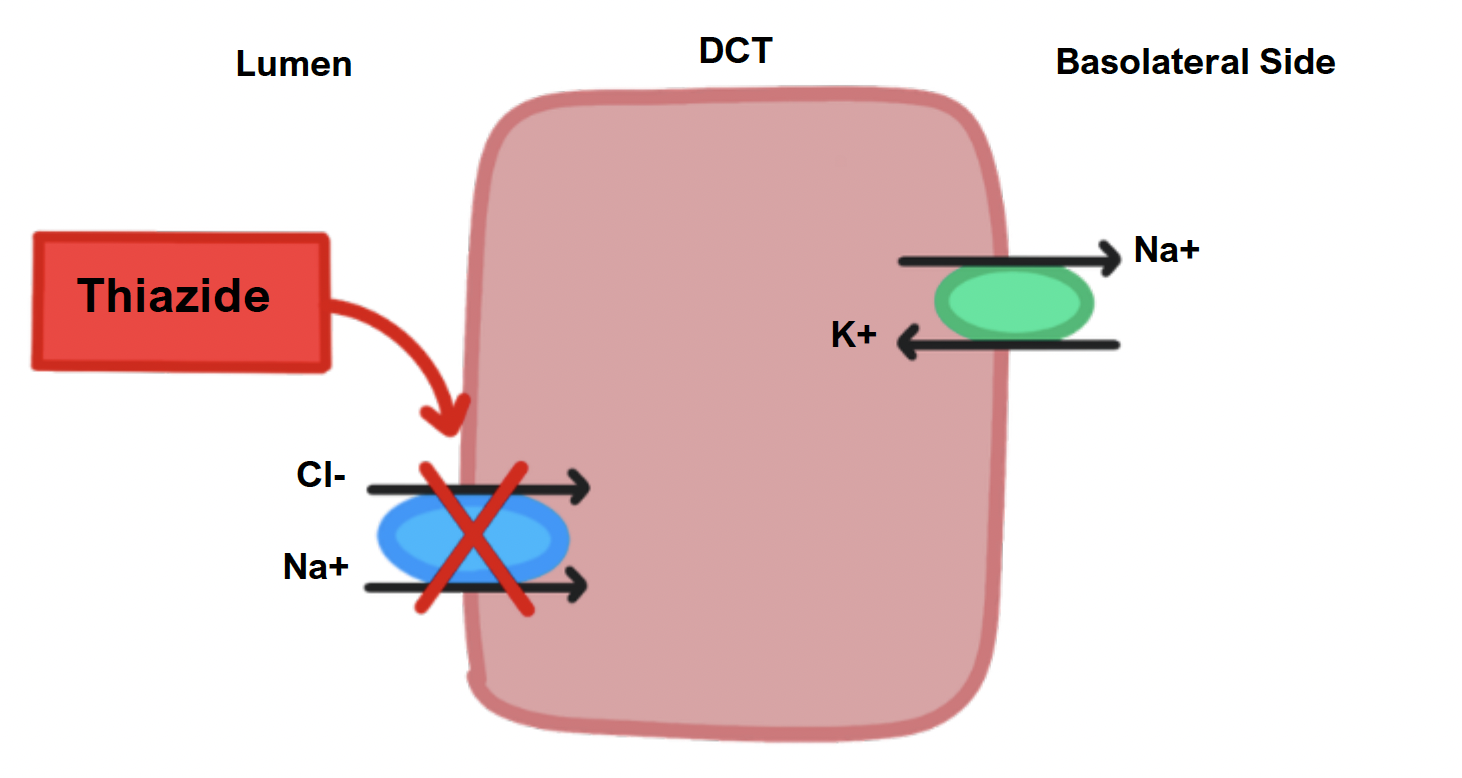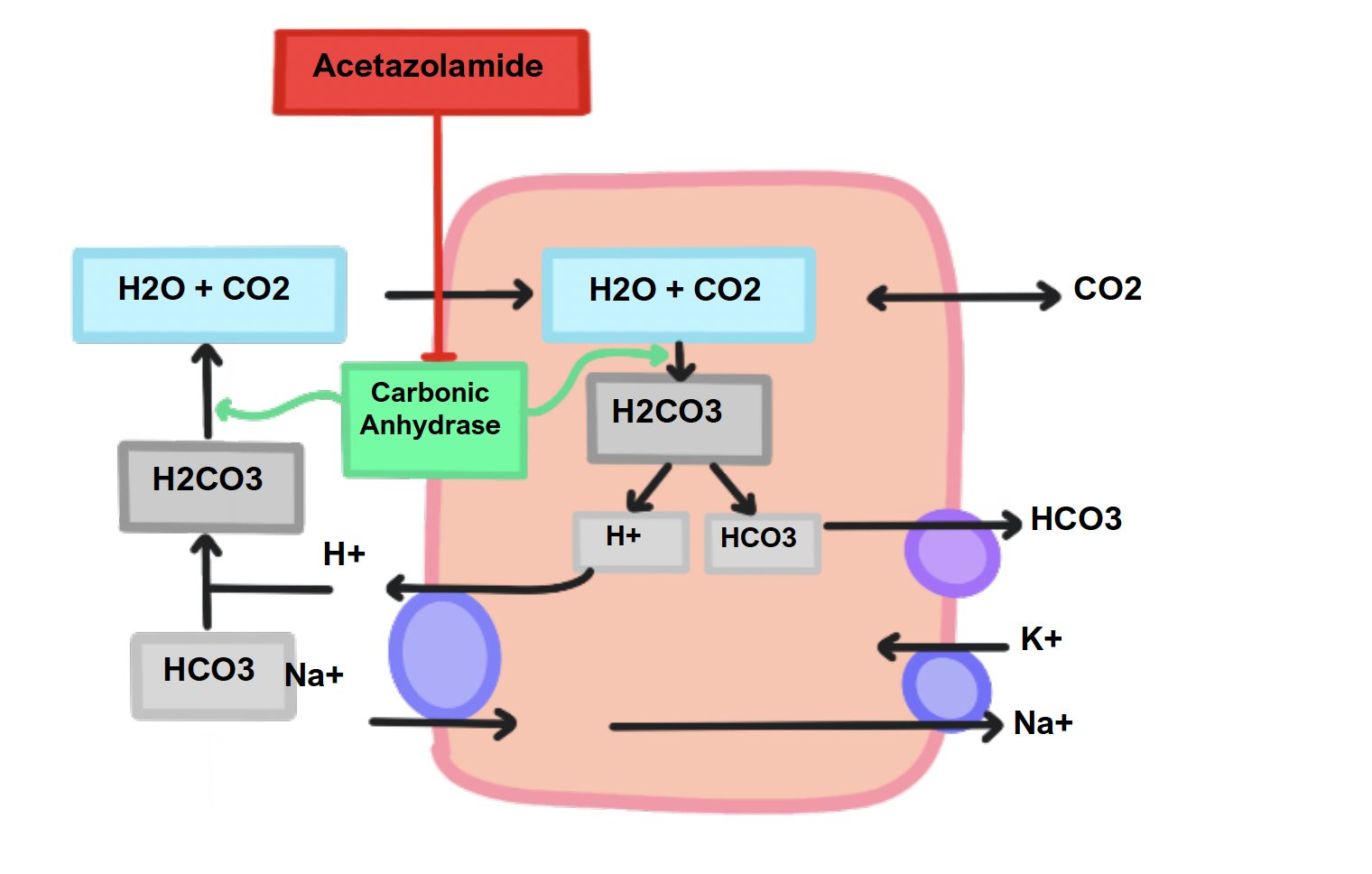Diuretics
Diuretics cause an increase in urine production by causing an increase in sodium excretion.
Loop diuretics – Furosemide, bumetanide
These are high ceiling diuretics which inhibit sodium reabsorption in the thick ascending limb of the loop of Henle, by inhibiting the NKCC2 transporter.
These drugs also increase renal prostaglandin levels increasing renal blood flow.
They are used in congestive heart failure and hypertension in people with poor renal function to offload water from the body.
They are also used to treat hypercalcaemia by increasing calcium excretion.

Side effects
Hyponatraemia and hypotension
Hypokalaemia due to enhanced K+ secretion
Metabolic alkalosis due to increased H+ secretion
Increased loss of Magnesium and calcium
Gout due to reduced uric acid excretion
Ethacrynic acid
This is a loop diuretic without the sulfhydryl group, used in sulpha-sensitive patients.
Thiazide diuretics – Hydrochlorothiazide, bendroflumethiazide
These drugs inhibit the active reabsorption of NaCl in the DCT by inhibiting the NCC, (NaCl) cotransporter.
They increase excretion of Na+, Cl–, K+ ions but reduce Ca2+ excretion.
They are used in patients with nephrogenic diabetes insipidus paradoxically as they reduce urine production as well as helping to prevent calcium-type kidney stones.

Thiazide-like diuretics – Indapamide, Metolazone
These are thiazide-like drugs which have a similar mechanism of action to the thiazide diuretics, inhibiting sodium reabsorption in the distal convoluted tubule.
They are the preferred class of diuretic in hypertension.
Indapamide is very useful for diabetic patients with hypertension.
Side effects
Hyponatraemia and hypotension
Hypokalaemia due to enhanced K+ secretion
Metabolic alkalosis due to increased H+ secretion
Reduced loss of Ca2+ (can lead to hypercalcaemia but helps prevent kidney stones)
Gout due to reduced uric acid excretion
Hyperglycaemia, hypertriglyceridemia and hypercholesterolemia
K+ sparing diuretics
These drugs antagonise the effect of aldosterone, decreasing Na+ reabsorption and increasing K+ secretion in the late distal convoluted tubule.
As a consequence, they are known as potassium-sparing diuretics.

Eplerenone, Spironolactone
These are antagonists of the aldosterone receptor.
They are used especially in hyperaldosteronism due to adrenal hyperplasia.
They are good at reducing blood pressure and are also used in the management of chronic heart failure.
Side effects
Hyperkalaemia with a concurrent metabolic acidosis
Gynaecomastia and menstrual abnormalities in women
Amiloride
This blocks ENaC channels stopping Na reabsorption.
Side effects
Hyperkalaemia leading to ventricular arrhythmias
Carbonic anhydrase inhibitors – Acetazolamide, methazolamide
These drugs inhibit sodium bicarbonate reabsorption in the kidney by inhibiting carbonic anhydrase in the PCT.
As HCO3 is not reabsorbed, Na+ is excreted as the major counter cation in the urine.
Consequently, water follows resulting in diuresis.
However, they are rarely used as diuretics as they are very weak.
Instead, they are used to treat acute mountain sickness and glaucoma (to reduce intraocular pressure) by decreasing aqueous humour production.

Side effects
Metabolic acidosis due to excessive excretion of bicarbonate
Associated with ammonia toxicity
Do not use in liver cirrhosis
Osmotic agents – Mannitol, glycerin
These are chemicals which are freely filtered and not reabsorbed by the kidney.
They retain their osmotic equivalent of water, pulling water into the urine.
They are used for reducing intracranial pressure for patients with cerebral oedema and intraocular pressure prior to a surgical procedure.
Disclaimer




